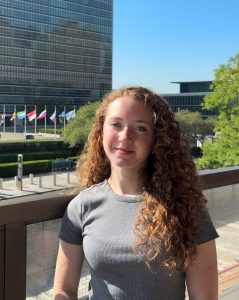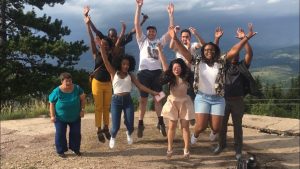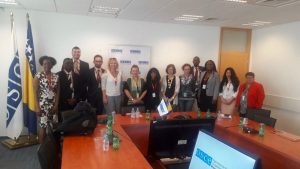by Robert Case | Oct 31, 2024 | Internship Experiences, Uncategorized, Undergraduate Students

My name is Charlotte Sens, and I am a Diplomacy and International Relations major with minors in Asian Area Studies and Data Visualization. This summer I am interning with the International Rescue Committee in their Workforce Development taskforce, finding work opportunities for refugees mainly coming from Haiti and the Middle East (Palestine and Syria). I mainly craft resumes and apply to jobs for our clients, while also completing intake meetings and doing data entry. I am communicating with many different people in different languages throughout the day, which occasionally presents challenges to clear communication. To expand on this, some of our clients will move out of state and fail to tell our organization, distancing themselves from the services we provide. Other times, I will organize a meeting with a client, but my translation will be slightly incorrect and the conversation will become redundant and frustrating as we both fail to understand each other. However, through this frustration, I have learned to be patient and how to productively address client frustrations while moving forward with our own goal to find them a job.
Refugeeism and migration are significant public concerns within the international community and domestically. This internship has brought to light systematic disadvantages that refugees face in coming to the United States. While I had previously learned of the refuge process in a previous class (ETW: Refugees, Religion, and Politics and International Relations of Southeast Asia), it is very different seeing it in practice. Many of our clients do not speak English or do not have substantial employment history or education or access to a car. As I try to find jobs to accommodate them, I find that many simple, entry-level jobs have unfair requirements far outside the qualifications of my clients. I find that my coursework with the school of diplomacy has helped remedy this, as I have been able to utilize writing and research skills to find businesses that will accommodate my clients, and the resources provided by the school of diplomacy has allowed me to cultivate professional skills so that I can confidently conduct myself both when I’m in the office and when dealing with clients and employers.
The professional skills I have learned throughout this experience, including professional communication and conduct as well as data entry and reporting skills, have made me more confident to enter the work force post-grad. I have also become more familiar with the operations of the migration and refugee system within the United States, and I can bring this knowledge to future experiences. I would highly recommend this internship to other students as it is highly rewarding work, and every task serves to aid refugees and improve their livelihoods. While it may be frustrating or demoralizing at times, it is a very positive experience to be able to help those in need.
by Robert Case | Oct 18, 2024 | Uncategorized

My name is Annie Hebel, and I am a Senior studying Diplomacy and International Relations, Spanish, and Journalism at Seton Hall University. Currently, I am interning with the Refugee Support Services (RSS) division of the International Rescue Committee in Elizabeth, NJ. In this role, I directly support a caseworker in her work with newly arrived families with some form of humanitarian parole, mainly from Haiti and Cuba. My daily tasks often include observing client intakes, filing public benefits applications, and assisting with client communication in Spanish and Haitian Creole.
The most interesting part of my job is getting to learn about the experiences of my clients and helping alleviate them out of difficult situations. Many people who enter the U.S. with humanitarian parole face a significant backlog of time before they can start to work or receive benefits, which often leaves them vulnerable to economic or financial exploitation. The support offered at the IRC helps prevent migrants from falling victim to this by providing a space for them to ask questions and learn about all of the options available to them for support.
This has been a particularly valuable experience thus far because, though I have gotten experience in various other forms of immigration work, I have never worked in a direct support role. Because I want to go into immigration, this is an invaluable experience. I am learning so much about how to respond to direct needs of migrants and develop relationships with organizations that can provide aid. I am also learning so much about how to communicate with clients who speak little to no English, improving my intercultural
communication skills. However, this has also been the biggest challenge – most of our clientele speaks Haitian Creole, which I am only just beginning to learn. It has proven a challenge to be able to fully support these clients and also adjust to using translation services.
Through my internship, I have confirmed that while I want to continue to pursue a career
in the immigration space, I feel as though I am not the most qualified for a direct support, social work-focused role and instead would prefer to work in the legal area of immigration. However, this position has been invaluable to help me develop skills that will translate, such as intercultural communication and a chance to learn and practice Creole. Overall, I would recommend this internship, especially for people who are interested in working with immigrant populations.
-Andrea Hebel, ‘24

by Catherine Ruby | Sep 24, 2018 | Uncategorized

 Author: Senhwa Horng, M.A. Candidate
Author: Senhwa Horng, M.A. Candidate
Sarajevo is a beautiful place. Beneath the rolling green hills, peppered with the red roof houses, stands the eclectic architecture of the storied and multi-cultured city. The old town sits quietly in the valley with its coppersmiths’ shops, cafes and ice cream stands, welcoming tourists with a quintessential languid, European charm. I visited Bosnia and Herzegovina in July, 2018 as part of a School of Diplomacy study seminar program led by Dr. Borislava Manojlovic to learn about peace and reconciliation in a post conflict nation.
During my short time there, I witnessed the beauty the country had to offer as well as the legacy of war that it carries on its shoulder. The people there are kind, gracious and generous in their hospitality. Yet, underneath the mask of tranquility, lies division. The war that tore the country apart in the 90’s left behind a bitterness and animosity that continues to hang over the three ethnic groups that make up the country’s population — they aren’t one Bosnian people, they are three distinct groups, the Bosniaks, the Serbs and the Croats. Time does not seem to have brought much healing.
Before our delegation departed the U.S., I was asked, “What interests you about Bosnia and Herzegovina? What do you hope to gain from your trip?” At the time, I couldn’t articulate well that what I wanted to see were the people who had lived through the realities of the war, the people for whom the terrors were neither fairytales nor simply the history of some distant land. In my sheltered and privileged life, I couldn’t understand war as more than an abstract concept. I wanted to learn about the Bosnian people’s experience and resilience. As I walked the streets alongside the locals who welcomed me into their shops and restaurants, I suddenly realized that the fields of international relations and conflict resolution are about people. As scholars, we cannot disassociate ourselves from the fields’ humanistic function of creating a safer world for people by understanding and preventing conflict.
As I reflect on my experience, there are three lessons that I know I will take with me, sometimes human nature collides with peace, hope and despair intertwine and peace belongs to those who fight for it.
Sometimes Human Nature Collides with Peace
Velma carried herself with the confident demeanor of a boss lady and her answers to our questions easily carried on into blusterous rants. She had a fierce passion, and from the moment I met her, I knew I liked her. My kind of girl, I thought. She knew what she stood for and she knew what she wanted to do, and she had a cause she was determined to fight for against all odds. The odds, it would seem, are stacked against her, and her fight proves to be a difficult one.
Velma is the founder and President of the Post-Conflict Research Center, an NGO that works to document stories of people during the war, stories such as those about heroic actions taken by ordinary people, stories about small actions that made a big difference.
“I also think storytelling is a powerful and intimate tool to help all sides see a conflict from the perspective of their enemies,” I said to her. In my naivety, there was a small part of me that thought, perhaps, the key to peace and reconciliation was right in front of me.
“It can be,” she replied, “Unfortunately, it’s not so easy to get people to listen to the stories of their enemies.” Velma explained, “We once tried to do a project that linked the stories of all three sides, side by side, and people were outraged. ‘You can’t tell the story of the Muslims, next to the story of the Serbs!’ they said.”
I thought to myself, Strange isn’t it? The opportunity to heal is right in front of them, and still there are people who would speak out against it. What could be more important than peace? What values are there in the world, so worth protecting, that would make a person choose to continue to hate their neighbor, over the opportunity to reconcile? It’s a stark contrast to see that in this world there are people like Velma who would fight for peace, and stand against division, and then there are people who would stand against peace, no matter the cost and no matter the reason. That’s what makes peace so complex, humans and all the multitudes of values, ideals, judgments and reasoning, both logical and illogical that come with being human.
Hope and Despair Intertwine
The Tunnel of Hope was a dangerous underground trek constructed during the Siege of Sarajevo in June of 1993. In the midst of war the tunnel was built by the Bosniak Army to create a passage through the Sarajevo Airport that would allow food, humanitarian aid, war supplies and weapons to be transferred into the city.
Today, this same tunnel, now called the Memorial Complex Tunnel D-B, is a museum, partially a tourist attraction, partially an educational resource. Our tour guide was a young woman who couldn’t have been much older than I am, but she had lived through the war, and through her stories and explanations an unfamiliar landscape came to life before my eyes. I could almost feel what it was like to spend a childhood in the backdrop of war.
“We didn’t have real eggs to eat during the war,” she said, “and my brother, who’s younger than me, he had never seen a banana until after the war ended. The first time he tried a banana he ate it with the skin still on.”
It seemed like a small detail beside the stories of violence that I had heard during in my time in the country, and yet the imagery of that seemingly trifling anecdote stuck in my mind, because to me, it was a picture of real life in a time of war.
Peace Belongs to Those Who Fight For It
The Genesis Project, an NGO working towards peace and unity in Bosnia and Herzegovina, shared the story of a school in a small town called Jajce. The regional government had made a decision to further divide the community along the ethnic lines that plagued it. The Bosniak and Croat students were separated into two different school buildings. But the children rose up and fought against the segregation. After a year of protest, their efforts were met with victory.
It was in that story that I learned that peace belongs to those who fight for it, and that the hope for peace can be found in unlikely places, in small towns and school children, and even in ourselves. Perhaps the responsibility of finding hope for peace, in places where it seems impossible, belongs to us all.
Senhwa Horng is a second year Graduate student from New Jersey, specializing in International Law and Human Rights as well as Post-Conflict State Reconstruction.
Save
by Katherine Campbell | Apr 10, 2013 | Uncategorized

We are proud to announce three Seton Hall University finalists for the Presidential Management Fellowship (PMF), Class of 2013: (1) Dalal Nadir, (2) Paige Fetzer, and (3) David Tucker. All three finalists are students of the Whitehead School of Diplomacy, exemplifying the School’s consistency to preparing quality graduate students.
Overall, this year there were 663 finalists from a competitive national pool of 12,000+ applicants.
‘Bearing the Presidential moniker, the PMF Program is a flagship leadership development program at the entry level for advanced degree candidates. It was created more than three decades ago by Executive Order and has gone through many changes over the years. The Program attracts and selects the best candidates possible, but is really designed with a more narrow focus – developing a cadre of potential government leaders. It provides some sustenance during the first years of employment and encourages development of leadership capabilities. The PMF Program inculcates a lasting bond as well as a spirit of public service, ultimately encouraging and leading to a career in the government.’
Learn more about PMF by visiting the official website here.
by Catherine Ruby | Apr 8, 2013 | Uncategorized
We’re proud to share Whitehead alumna, Emily Coady’s latest blog post on her experiences as an American India Foundation Fellow at RIVER, an experience made possible by AIF’s William J. Clinton Fellowship for Service.
Read Emily’s post here .
.








